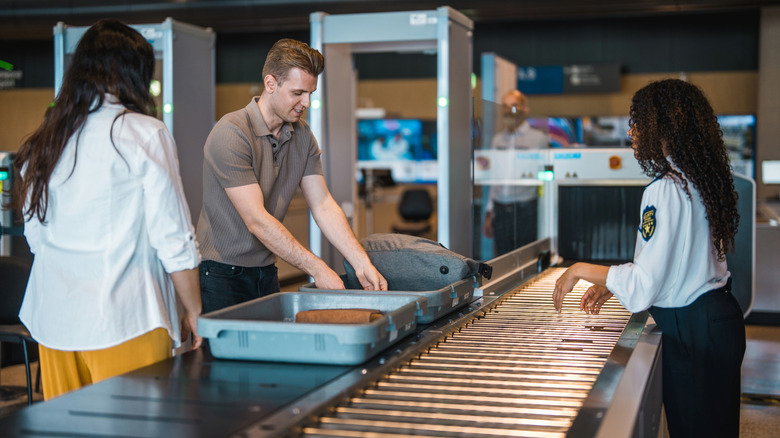Why Some Airports At TSA Make You Take Your Laptop Out Of Your Bag And Others Don't
By now, every seasoned traveler knows the routine when lining up for airport security: Take off your jacket, clear everything out of your pockets, and remove your laptop from its case. It's something that's been in place for a long time now, which is why you might be surprised to hear TSA tell you that you can keep your laptop in your bag at certain checkpoints. So, why is it that you need to take your computer out in some airports and not at others? It's all about technology.
Certain airports have installed advanced equipment called Computed Tomography (CT). If the concept of a CT scan sounds familiar, that's because it's commonly used in the medical field to diagnose a range of injuries. These scanners create 3D images that are far superior to the 2D images produced by traditional airport X-ray scanners. Not only can CT scanners create a 3D image of your carry-on bag, but that image can then be rotated and viewed in a manner that allows TSA to see if there is anything worrisome inside, including explosives and large quantities of liquids.
How does this relate to laptops? Under the old X-ray scanners, it was difficult to see through the computer's battery and electrical components, as they are too dense to penetrate. This made it difficult for TSA agents to see all the contents of your bag. The upgraded CT scanners don't have this issue, and thus, your laptop can stay inside. Over the past few years, TSA has earmarked $1.3 billion to upgrade its technology, which means you'll see more and more airports where removing liquids and laptops, as well as taking off your shoes, is a thing of the past.
CT scanners are being introduced to more airports at home and abroad
While not all major airports in the United States have CT scanners — which means you'll still need to remove your laptop and electronics from your bag in some checkpoints — an estimated 255 out of 432 airports in America use them as of May 2025, according to a TSA administrator. Less fussing with your bags also means increased efficiency, so you should see wait times drop dramatically at airports where the new technology has been implemented. Many of the country's busiest airports, like Atlanta Hartsfield-Jackson, Chicago O'Hare, and Dallas-Fort Worth, already have these scanners in place.
International travelers will also encounter these advanced scanners on their travels. Rome Fiumicino, Amsterdam Schiphol, and Edinburgh Airport are all using CT scanners, while other airports like London Heathrow have them partially implemented. All this is to say that you should be prepared for different airports to have different regulations depending on the equipment they have installed, which makes reading the signs and listening to staff at security all the more important.
Thanks to these upgrades, airport travel just got a lot more convenient. And with TSA teasing the possibility that it might finally loosen its restrictions on carry-on liquid size, things are looking up for the future. These time-saving measures also mean that it's more important than ever to evaluate if TSA PreCheck is worth the investment. Depending on the frequency of your travel and what airports you use, it may not be as valuable as it used to be.

